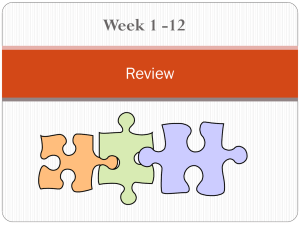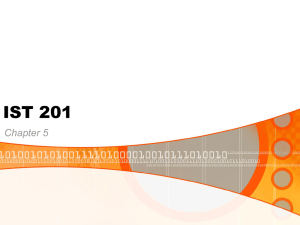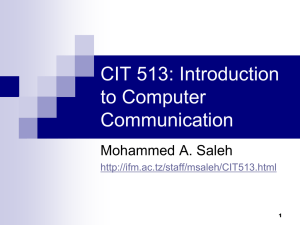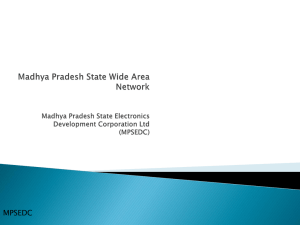Ethernet Types Media Max segment length Connector
advertisement
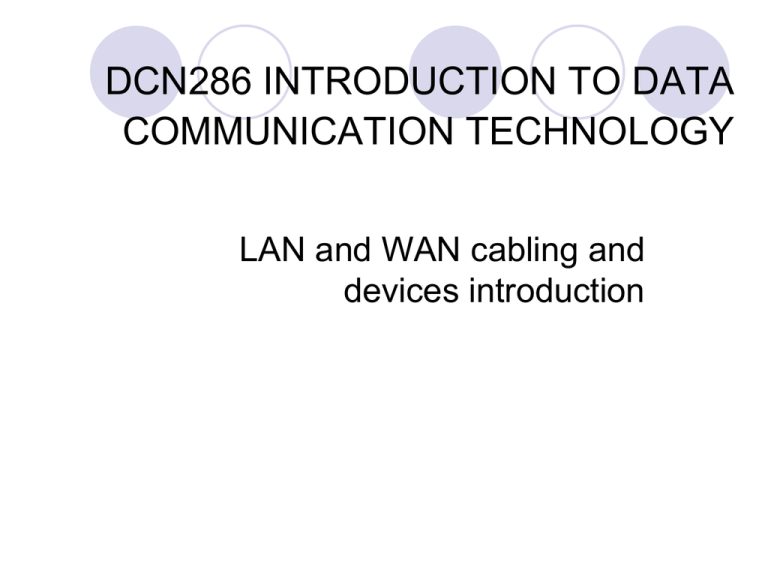
DCN286 INTRODUCTION TO DATA COMMUNICATION TECHNOLOGY LAN and WAN cabling and devices introduction Digital signal transmission Electrical signals can be transmitted over coaxial cable, STP, UTP cables Light signals can be transferred over fiber optic cable which has advantages over copper: • SPEED: Fiber optic networks operate at high speeds up into the gigabits • BANDWIDTH: large carrying capacity • DISTANCE: Signals can be transmitted further without needing to be "refreshed" or strengthened. • RESISTANCE: Greater resistance to electromagnetic noise such as radios, motors or other nearby cables. • MAINTENANCE: Fiber optic cables costs much less to maintain. Review of Ethernet cables Ethernet Types Media Max segment length Connector 10BASE2 50ohm coax (Thinnet) 185m BNC 10BASE5 50ohm coax (Thicknet) 500m AUI 10BASE-T TIA/EIA Cat3, 4, 5 UTP 100m RJ45 100BASE-TX TIA/EIA Cat5 UTP, 2 pairs 100m RJ45 100BASE-FX 62.5/125 multimode fiber 400m Duplex media interface connector (MIC), ST or SC 1000BASE-CX STP 25m RJ45 1000BASE-T TIA/EIA Cat5 UTP, 4 pairs 100m RJ45 1000BASE-SX 62.5/125 multimode fiber 275m for 62.5 micro fiber; SC 550m for 50 micro fiber 1000BASE-LX 62.5/125 multimode fiber; 9micron single mode fiber 440m for 62.5 micro fiber; SC 550m for 50 micro fiber; 3-6km for singlemode fiber Connectors (optional) LAN review Local Area Networks (LAN) is a collective group of computers, or computer systems, connected to each other allowing for shared program software or data bases. LAB should have high speed and reliable connections. LAN can fall in 3 categories: 1. End-user level: linking user equipments (PC, laptop, PVR) to a hub/switch/router. 2. Workgroup level: linking between hubs/switches which are used to connect user equipments. 3.Backbone level: Links between the hubs/switches in LAN core Switches and Links Access switches and links Access switches are used in LAN connecting user devices. The links of access switches are Access Links. Distribution switches and uplinks Those access switches are connecting to upper level switches, distribution switches. Links between access switches and distribution switches are uplinks. Core switches and links The distribution switches are connected to central switches, core switches. Links between distribution switches and core switches are core links. Switches used in Data Centre (optional) Switches used in Campus LAN (optional) Switches used in branch (optional) Switches used in Service Provider (optional) UTP cable pin outs The TIA/EIA T568-A and TIA/EIA T568-B are the standard to prepare the Ethernet cables. It is a kind of essential skills for a network tech. For straight through cable, sequence is same on both ends. 100Mbps crossover cable For 100BASE-T, only two pairs cross each other on both sides. Look that the pin 1 and 2 of side A are placed as pin 3 and 6 on another end, side B. Pin 3 and 6 of side A are placed on pin 1 and 2 on another end, side B. 1000Mbps crossover cable For 1000BASE-T, all four pairs are cross each other on both sides. Transmit pins Pin 1 and 2: PCs, routers, servers, wireless access points Ethernet connection Pin 3 and 6: Switches, hubs, bridges, repeaters Connection of straight through cables Switch to router Switch to PC or server Hub to PC or server Crossover cable Switch to switch Switch to hub Hub to hub Router to router PC to PC Router to PC Auto-mdix (Automatic Mediumindependent Crossover) If the Auto-mdix is enabled by default, straight-through cable can also be used between two switches But, it is possible the feature is disabled by default. Please verify manufacturers’ documents. Standard Tests for Cable Certification Wiremap: Identify physical error of any mis-wiring Insertion loss: Lose of signal strength, expressed in dB. NEXT: A higher value is desirable, meaning better cable performance PSNEXT: Combined NEXT Equal-level Far-end Crosstalk (ELFEXT): FEXT is usually less detrimental to a signal than NEXT Power sum equal-level far-end crosstalk (PSELFEXT): sum of all FEXT Return loss: measured in dB and indication of bad crimp or bad connection at the RJ45 plug. Propagation delay: tests for the time it takes for the signal to be sent from one end and received by the other end Cable length: Verify not exceed 100m. Also find shortcut or where the broken point is Delay skew: Tests for difference between the fastest and slowest set of wire pairs. Lower is better. Could be between 25-50 nanoseconds over 100m Repeater The digital signals are transferred by electrical, light, microwave and other wireless energies. Those energies would be degraded and that is the reason why the max length of single segment length of various cables could be defined. To remain the signal strength, repeater can amplify degraded signals back to clear signal level. 5-4-3 rules for repeater Repeaters cannot be used to extend network without limit. 5-4-3 rules in 10BASE-T: Max. 5 cables and 4 repeaters can be used between any 2 end user devices. Only 3 can have end user devices connected. Hubs Central connection device Repeat the incoming signals before transmitting them on to their destinations Passive, active and intelligent are three Ethernet hub types. ***Hub is working in physical layer of TCP/IP ISO/OSI model. Network Bridges Can connect multiple network segments and regenerate clear signals Can analyze incoming data packets by the destination MAC address before rebroadcast them to other segments: forwarding (if the destination is reachable on the other side) and filtering (if the destination is on the same side) Work in layer 2 of ISO/OSI TCP/IP model Ethernet switch Can connect multiple segments with regenerating clear signals Can handle multiple frame forwarding/filtering simultaneously. May offer VLAN (Virtual LAN) features Can support full-deplex mode Switch works in layer 2. Wireless tech introduction Infrared Bluetooth Microwave Radio Wi-Fi In general, wireless network is secondary because of two concerns: speed and security. But, it does offer mobility and convenience. Main wireless components Access point: linking wireless network to the wired world. Wireless NIC is required on each hosts in the network with authentication configuration. Wireless hub, switch and router: functioning as same as regular wire connected equipments WLAN standards organizations IEEE published the WLAN standard. FCC (Federal Communication Commission) will specify restriction on power and radio frequencies in US. Industry Canada is taking care of radio frequency usage in Canada. Frequency use/approval may be different in various areas, regions and countries. NIC (Network Interface Card) The most common language or protocol for LANs is Ethernet, sometimes referred to as IEEE 802.3. (FDDI and Token Ring are other LAN protocols) LAN model Peer to peer (Also referred as workgroup model) No central authentication. Host could be server and client in different times Client/Server (Some people called this as domain model) Central authentication is handled by domain controller. Resources are shared on server side and client PCs are connecting via network. WAN (Wide Area Network) WAN could be thought that many LANs are connected by: Dedicated connection (physically private owned) Leased Line between LANs (Logically private owned) Remote connection over public network connection (Internet connection): VPN (Virtual Private Network), RAdmin, PCAnywhere, GoToMeeting, LogMeIn, VNC or other remote access software VPN (Virtual Private Network) (optional) Main components: VPN server (could be a dedicated box, hardware VPN server or a software program running on a server) VPN client (could be a dedicated box, hardware VPN client usually linking sites or a software program running on a client computer to connect to VPN server) VPN protocols: L2TP (Layer 2 Tunnel Protocol) or PPTP (Point to Point Tunnel Protocol) Internet connection Dialup (adding modem to analog telephone line with connector RJ11) T1 (1.5Mbps), T3 (45Mbps) are using CSU/DSU network with RJ48 connector) DSL (ADSL, SDSL, VDSL, HDSL, etc, etc): Digital Subscriber Line is to transfer voice and data over digital phone line Frame Relay Cable internet connection (Coax cable) IDSN (RJ11 and RJ45 connections) Cell phone and other Mobile Hi-Speed Internet Satellite connection T1/T3 connector (Optional) Bantam connectors might be used by T1/T3. ISDN “modem” (optional) The correct name should be ISDN terminal adapter You can find external or internal adapter in which RJ11 connections are used to connect digital phone line and RJ45 is used to connect to LAN. Satellite Antenna (optional) Serial port connection Most WAN links are serial connection. Such connections require CSU/DSU (Channel Service Unit/data Service Unit). You can understand it as a “modem” or “adapter” between your LAN and WAN link. It is possible to have a connection adapter to convert the serial port connection to RJ45 style. DTE/DCE DTE (Data Terminal Equipment) DTE is usually end user device and it receives clocking. DCE (Data Communication Equipment) DCE is usually on upstream side and it defines clocking (transfer speed) for DTE. The male and female connections as the picture Serial port connectors Connection Side A EIA/TIA-232 25 pins Side B 9 pins EIA/TIA-449 37 pins 9 pins V.35 30 pins 9 pins X.21 15 pins 9 pins EIA/TIA-530 25 pins 9 pins Cisco DTE/DCE connectors (optional) Cisco EIA/TIA-232 (RS-232) DCE cable has female connector (holes) on the D60 connector side Cisco EIA/TIA-232 (RS-232) DTE cable has male connector (pins) on the D60 connector side Fixed or modular routers If the router has only permanent interfaces, it is a fixed router and you cannot add any extension cards inside. Cisco routers could be modular style in which, additional interface (modular) cards are allowed to be inserted Cisco fixed router Cisco modular router The two plates cover the potential extension cards inserting in upper section of the Cisco 3640 router Extension module card (optional) Cisco High-Speed WAN Interface Card expansion module Cisco High-Speed WAN Interface Card serial adapter Cisco WAN Interface Card (WIC) - 4 x 10/100Base-TX WAN - WAN Interface Card (WIC) Cisco 1-port ADSLoPOTS WAN Interface Card - 1 x ADSLoPOTS WAN - WAN Interface Card (WIC) Cisco router console cable Beside connecting RJ45 to fast Ethernet ports, DTE or DCE cables to serial ports, console cable (roll-over) is used to connect Cisco router console port to computer serial port In Hyper Terminal, have following setup 9600bps 8 data bits No parity 1 stop bit No follow control Remote control the router (Optional) In general, router could be managed by: Console (directly connected) Aux port with modem connection Network control via Ethernet or serial port Question Any question? If you do not have question, please search internet and collect more information of those LAN, WAN, switch and router. Such as brand and makers’ name 1. Please be aware regular models of Cisco router and switches. 2. Please be familiar with those hardware and concepts.

